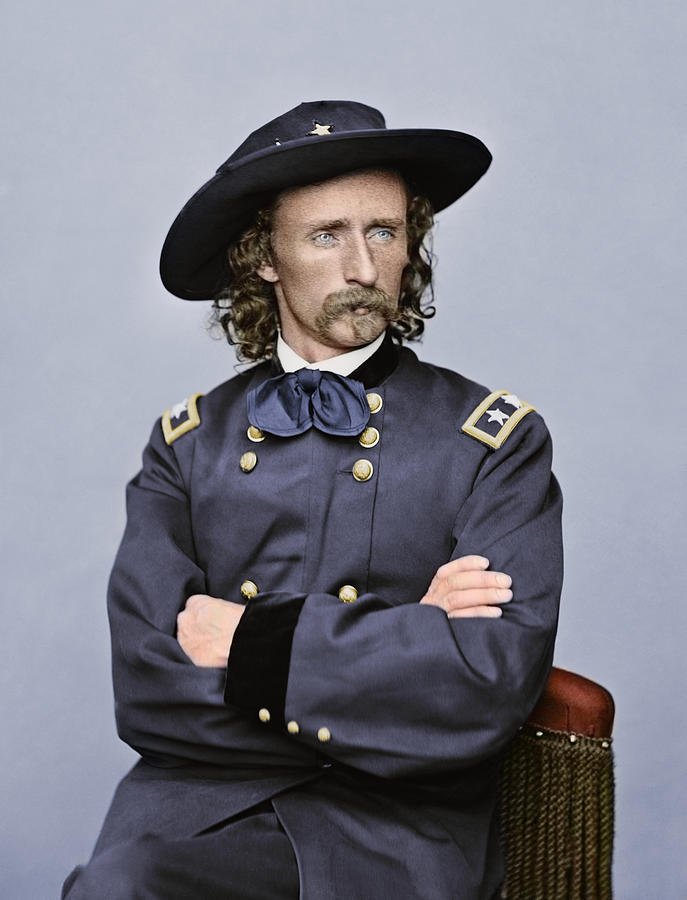
ON THIS DAY IN HISTORY, 1868: Colonel George Custer massacres Cheyenne on Washita River
Without bothering to identify the village or do any reconnaissance, Lieutenant Colonel George Armstrong Custer leads an early morning attack on a band of peaceful Cheyenne living with Chief Black Kettle. (remainder of this appalling bit of Americana here and big thanks to HISTORY.COM for the constant reminder about what we lose when we don’t read, understand, and occasionally let those who didn’t win write or revise history).
I share this because while it infuriates me and makes me wanna holler, it’s also worth noting that American history is littered with cowardly, powerful men who made money, careers, and their places in HISTORY BOOKS by killing, disempowering, dispossessing, and mostly using all of their inherited power or influence or the opportunistic ways our world often rewards those shameless enough to do whatever it takes to get over, and what we’re seeing in 2024 is, while nothing new, a sort of super-sized version of this venality, this selfishness, this obsession with self and glorification of inhumanity, this “I got mine and the only way I can wake up every day is to do everything I can to make sure I not only get more but that THEY don’t get any” which sounds really hippy-ish and commie-like, but this mantra, an ethos, not only is celebrated, but practically inculcated in movies (think of Wall Street and how Gordon Gekko is seen as the good guy and how connecting those dots with the ’80s and Reagan and Trump starts to make one connect more dots with Jeff Bezos, newspapers and social media (ahem) outlets being owned by billionaires and what gets sold as Truth and how America is Made Great Again by white dudes thinking white thoughts doing white things all so the great green glow of dough can crowd out the sight of other colors, other sexes, other possibilities).
(And, of course, our artists–the poets in particular serving as unacknowledged legislators–are the ones who get this shitheels in their sights and do what the History books won’t and can’t:
Buffalo Bill ’s
defunct
who used to
ride a watersmooth-silver
stallion
and break onetwothreefourfive pigeonsjustlikethat
Jesus
he was a handsome man
and what i want to know is
how do you like your blue-eyed boy
Mister Death
YES E.E. Cummings–thank you for this.)
But don’t think of it too much. And despite all of this I can be grateful, truly and profoundly humbled that despite all this our world has always had those who dedicate every aspect of their existences to creating beauty, and sharing it. For me, near the top of that list is the immortal Ludwig van Beethoven, and while I’d never want to pick one piece, I always start with this b/c it’s not necessarily the composer at the height of his god-like powers, evidenced by the later works (the symphonies and string quartets especially); this is him at his most human, stretching, making himself slightly uncomfortable to uncover the types of sounds we hadn’t heard, this is not the mature Martin Scorsese of Goodfellas (a lot more on that masterpiece here) or ‘The Departed’; this is the young, lean, mean visionary making a mess with Mean Streets and Taxi Driver (much more on both of those masterpieces here and here), willing to die to see it done right, almost killing himself to see the vision of what’s possible made reality through art, to showcase our ugliness and vulnerability so that we might see ourselves more clearly, confront that shame, and be better. And I love Daniel Barenboim (more on him, here) for being –in my estimation– the most perfect contemporary distillation of what Beethoven intended.

Speaking of Beethoven, here’s my essay celebrating him on the occasion of his 250th birthday, here.
TL;DR; here’s my .02:
How to summarize such an output? How to get a handle on the scope of this achievement?
If the symphonies are novels, the operas screenplays, the concertos and quartets short stories, the piano sonatas are poems. One human being, one instrument: an entire universe of feeling and emotion. I would never want to be forced to choose what represents Beethoven’s “best” work (although the 3rd and 5th piano concertos would be impossible to dispense with, the late string quartets, of course, plus the 3rd, 5th, 7th, and 8thsymphonies, all the overtures, and so on).
It’s with the heft of a full, engaged orchestra behind him that Beethoven seems most godlike, each individual instrument another arrow in his quiver (or cannon in his artillery); it is while conducting—or even composing—these sweeping masterworks that we envision the stern, mercurial, heroic genius gazing down at us mere mortals. For me, it’s the sonatas that reveal Beethoven at his most human, not merely because it’s just him and a piano, but his mind and the creative tension and exploration of the at once limited and limitless sounds those keys can make.
The sonatas, with titles that seem so mysterious and exhilarating: Pathetique, Appasionata, Mondeschein. My first exposure to Beethoven’s piano sonatas was courtesy of the great Daniel Barenboim’s initial recordings (from ’67; he revisited the cycle many years later). It was that time in my life (age 17); it was that era in general (1987, one of the very first compact discs I owned) but mostly it was the music. Indelible and unforgettable. Then, and now. Bottom line: this is my favorite music in the world, and if there was one title I had to take with me to that clichéd desert island, it would be Barenboim’s set of Beethoven sonatas.
